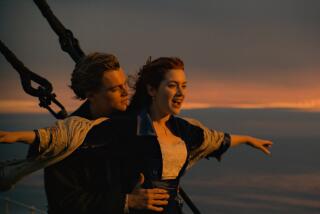Is the world ready for another good ‘Titanic’ cry?
In the late 1990s, a peculiar global fever broke out. Boys in Afghanistan began cutting their hair like Leonardo DiCaprio, girls in Japan held parties to weep together while listening to “My Heart Will Go On” and cruise line staffers had to keep peeling adventuresome passengers from the bows of their ships.
The whole world, it seemed, needed a good cry — and found it in the movie “Titanic,” James Cameron’s extravagant retelling of the luxury ocean liner’s 1912 sinking. After its 1997 premiere, “Titanic” sailed on to gross $1.8 billion globally, a record that would not be surpassed at the box office for 12 years — until Cameron’s 2009 3-D fantasy “Avatar.”
Beginning Tuesday night, “Titanic” will return to theaters, this time in 3-D, in the U.S. and more than 100 other countries. In re-releasing his romantic disaster epic, Cameron is courting a broad audience of nostalgia-driven adults, fans who were too young to see “Titanic” on the big screen the first time around and moviegoers in countries such as China and Russia where theaters were few and far between during the film’s initial run.
TIMELINE: Titanic, a century in film and television
“Titanic” foreshadowed many trends in Hollywood — its then-jaw-dropping $208-million production budget and global box office reach have since become standard among studios making fewer and costlier films with an eye toward international audiences. But the period romance also signaled the end of a certain kind of filmmaking, which relied on a scale model of the Titanic that Cameron built in Mexico, instead of the now common computer-generated sets.
“Titanic 3D” will not likely reach the box office heights of the film’s initial release — industry analysts expect it to open at $25 million to $30 million in the U.S. But the movie will serve as a strong test case for the business model of 3-D re-releases, in which studios convert their catalog titles for stereoscopic viewing — often for about $10 million — and market them as a new cinema-going experience. The strategy got a boost from the unexpected $94-million domestic box office take of “The Lion King 3D” in September; a release of “The Phantom Menace 3D” earned $43 million in February; and 3-D conversions of the rest of the “Star Wars” films, various animated Disney and Pixar titles, and live action movies such as “Jurassic Park” and “Top Gun” are in the works.
“We knew a film that played worldwide was critically important,” Cameron said last week by phone from Tokyo, of whom he had in mind when writing “Titanic,” which centers on a privileged 17-year-old girl (Kate Winslet) who falls for an artistic drifter (DiCaprio) against the backdrop of history’s grandest nautical tragedy. Its themes of young love, class difference and courage in the face of disaster — not to mention the meticulously re-created spectacle of the ship’s sinking — appealed to a wide audience.
“I guess I write in a way that critics who don’t like me consider cliché, but audiences who do like me consider archetypes that they can invest in,” added Cameron, who was in Tokyo for the Japanese premiere of “Titanic 3D.” “I like relatively simple messages that are served up in lavish visuals. I don’t want to be obscure about what I’m trying to say. Filmmaking is an instinctive process. You try to make a good movie and if it plays, it plays.”
Fifteen years ago, “Titanic” played ... and played ... and played. In the U.S., the movie held the No. 1 spot at the box office for 15 consecutive weeks — a record that still stands — and earned 11 Academy Awards.
“This movie defines pre-awareness,” said Jim Gianopulos, co-chairman and chief executive of Fox Filmed Entertainment, which is releasing “Titanic 3D” internationally. “There isn’t anyone who isn’t aware of ‘Titanic.’ But the experience and the newness of the 3-D conversion is what has people excited.”
In the winter of 1998, Russians lined up to see “Titanic” on one of 32 available movie screens; “Titanic 3D” will play on 10 times that many screens in Russia.
“I have never cried so much in my life as I did when I first watched ‘Titanic’ on the big screen,” said Anna Pechnikova, a 34-year-old Moscow schoolteacher. “I often listen to the movie’s soundtrack on my stereo at home and I’m looking forward to the coming 3-D release, which I am sure will help me to experience new emotions.”
In its first run, “Titanic” also played especially well in Asia, where the film’s theme of self-sacrifice helped it premiere to wild enthusiasm at the Tokyo Film Festival and secure a surprising endorsement from then-Chinese President Jiang Zemin. Jiang called the film “moving” and told a group of legislators, “Let us not assume we can’t learn from capitalism.” Though pirated copies of the movie were widely available on Chinese street corners at the time, “Titanic” grossed $57 million there on 180 screens. This time, “Titanic 3D” will reach more than 2,400 screens in China. Cameron, a vocal proponent of the 3-D format, first suggested converting “Titanic” in 2004, but had trouble finalizing a deal with his two studio partners, Fox and Paramount Pictures, which share the rights. “They were predisposed to do it,” Cameron said. “But it was like the two divorced parents having to come to terms on the kid’s college fund.”
In 2009, the outsized success of “Avatar” provided the impetus the studios needed, and theaters around the world began rapidly adding 3-D screens. “‘Titanic 3D’ went from being an incredibly radical concept in 2004 when we first proposed it to a sound business model,” Cameron said.
With this month’s 100th anniversary of the Titanic’s sinking as a deadline for the project, Fox and Paramount agreed to share the $18-million expense of converting “Titanic” to 3-D. The process took 60 weeks to complete and the work of hundreds of technicians, according to producer Jon Landau.
The success of the endeavor depends on the willingness of audiences to pay premium 3-D ticket prices to see movies that have been available on home entertainment formats for years.
“Are people really clamoring to re-experience ‘Titanic,’ or is it just a convenient hook to re-release what was once the highest-grossing movie ever made?” asked Kevin Sandler, editor of the book “Titanic: Anatomy of a Blockbuster” and associate professor of film and media studies at Arizona State University. “The fact that it’s being reissued to coincide with the 100th anniversary, it seems more like commercialization of a tragic event and playing the 3-D card in order to make extra income. That may make it a nonevent, and maybe it’ll just do the same numbers as ‘Star Wars.’”
In the U.S., “Titanic” has been available for home viewing since 1999, but Paramount, which owns the domestic theatrical rights, is releasing “Titanic 3D” on a 2,650 screens. Megan Colligan, Paramount’s president of domestic marketing and distribution, said 3-D is only one facet of the marketing for “Titanic’s” re-release.
“You don’t ever want the 3-D to feel like a gimmick,” Colligan said. “It’s an important part of the messaging, but isn’t the whole message. The film has been remastered and it’s a special event. The experience of seeing this movie theatrically, sitting in a dark room with 300 people, is totally different from watching it on a TV.”
According to tracking surveys, young women are the most interested in seeing the 3-D version — the same group that helped drive “Titanic’s” run last time with multiple repeat viewings.
Paramount’s marketing has targeted females, with a promotion during ABC’s “The Bachelor,” a spot during the Academy Awards broadcast and 50 sneak screenings around the country on Valentine’s Day. Teen girls in particular have helped spur interest in the film on social media, pushing the “Titanic” movie Facebook page up to 18 million likes. (The Facebook page for “The Hunger Games” movie, this spring’s slightly female-skewing box office champ, has 3.6 million likes).
“It doesn’t surprise me that the people who are admitting they want to see the movie are 14-year-old girls,” said Cameron. “It’s the idea of romantic love... a love that completely sweeps you away. It’s really about Kate’s character, about the example she sets of how a young woman deals with issues of identity and societal suppression of her individuality. All girls go through it to some extent. They can relate to her. But men will go, couples will go, families will go. The 14-year-old girls were the repeat offenders last time, but by the end we were about 50/50 male-female. Look, those girls have to go to the movies with somebody.”
Times staff writer Sergei L. Loiko in Moscow contributed to this report.
More to Read
The biggest entertainment stories
Get our big stories about Hollywood, film, television, music, arts, culture and more right in your inbox as soon as they publish.
You may occasionally receive promotional content from the Los Angeles Times.











